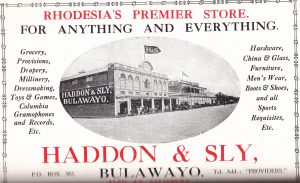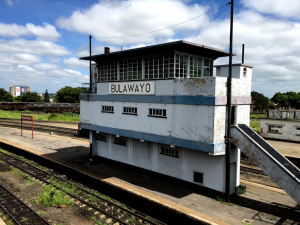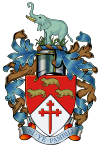 Bulawayo is the second-largest city in Zimbabwe after the capital city of Harare. According to the 2012 census it has a formally documented population of 653,337 though the number of residents is likely quite a lot higher.
Bulawayo is the second-largest city in Zimbabwe after the capital city of Harare. According to the 2012 census it has a formally documented population of 653,337 though the number of residents is likely quite a lot higher.Located in the province of Matabeleland it is 439 km (273 mi) southwest of Harare and relatively close to the borders of Botswana and South Africa. For political reasons, in all probability, it is treated politically and economically as a separate provincial area from Matabeleland.
It;s a town where I spent 15 years as a child before going to University in South Africa and it is distinctive and holds fond memories for me. It is a City that I remain tied to for now, and probably forever.
Bulawayo has some unique traits that single it out from the supposedly more prestigious capital.
Home of Lobengula
Although the location of the current CIty of Bulawayo is not exactly where King Lobengula of the Ndebele nation had his original home, it is close.
Lobengula Khumalo (1845–1894) was the second and last king of the Northern Ndebele people (historically called Matabele in English).
Lobengula was a big, powerful, man with a soft voice beloved by his people and loathed by foreign tribes. He had many wives. His father was Mzilikazi – first king of the Northern Ndebele people.
The first automobile north of the Limpopo River
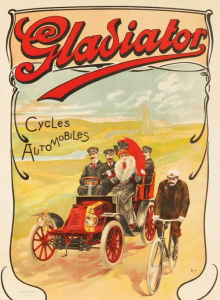 In 1902, Charles Duly who had a cycle agency in Bulawayo (most will remember the car dealer Duly’s) imported a French 6½ horsepower ‘Gladiator‘, the first car to arrive north of the Limpopo, in Bulawayo.
In 1902, Charles Duly who had a cycle agency in Bulawayo (most will remember the car dealer Duly’s) imported a French 6½ horsepower ‘Gladiator‘, the first car to arrive north of the Limpopo, in Bulawayo.The arrival of the Gladiator caused something of a stir in Bulawayo. likely due to the dearth of other traffic on the tracks, there were no apparent rules in play for mechanical horses at the time and so Duly likely did not need a warning flagman in front of his machine.
City status for Bulawayo
Bulawayo was declared a town in 1894, one year after what is known as the Matebele War.
It was given municipality status in 1897 and had 6 Councillors at the time.
It would take the town a further 50 years until 1943 to be accorded the title of city.
Bulawayo was officially declared a city on November 4, 1943. The population then was around 100,000 people. Twenty years later the population, in 1968, has grown to 200,000.
Founding of the first Rhodesian newspaper
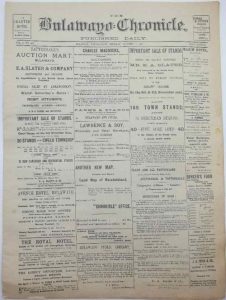 Bulawayo’s first newspaper was The Chronicle which was launched as a twice weekly newspaper in 1894 by the Argus Company of South Africa and by the following year it had its first advertisements which covered most of the professions and services in the area.
Bulawayo’s first newspaper was The Chronicle which was launched as a twice weekly newspaper in 1894 by the Argus Company of South Africa and by the following year it had its first advertisements which covered most of the professions and services in the area.By 1895 The Chronicle moved to a daily newspaper, of which it is still today. Unfortunately like so many newspapers, its relevance has dwindled and even more so now that the internet is relatively accessible to many.
The paper was considered a monopoly newspaper of Bulawayo after the printing of the The Daily News was banned in 2003 due to its critical reporting of Mugabe’s government. As an organ of Zimpapers many regard it as nothing more than a political mouthpiece.
Streets wide enough to turn an ox wagon
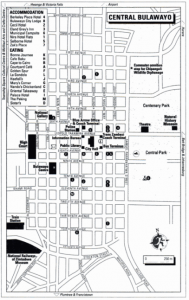 The design of the streets of Bulawayo are rather distinctive, and this was for one fundamental reason: sixteen span oxen carts turning.
The design of the streets of Bulawayo are rather distinctive, and this was for one fundamental reason: sixteen span oxen carts turning.The city had wide streets that were designed to be broad enough to allow a span of oxen to turn without difficulty, a provision which ultimately greatly assists the city’s traffic even in today.
Laid out on a grid, the terrain is flat and one way streets are few and far between.
The iconic Haddon & Sly Department Store and tearoom
In the early days it billed itself as the “Premier Store for Anything and Everything” – to be sure, even into the late 1970’s despite competition from OK Bazaars, Meikles and Woolworth Stores, you could buy almost anything at H&S.
H&S was, the “Harrods” of Bulawayo and even provided a delivery service. The building grew from a two story building to a multi storied building with prominence opposite the City Hall and had a renowned tea room and grocery store.
A railway Line
Running through the protectorate of Bechuanaland now modern day Botswana, the idea did not come from the imperialist Rhodes but more for its ability to provide the British South Africa Company with leverage over the Transvaal Republic .
The railway was important to Rhodes more for this short-term political leverage that it gave him than for the fulfilment of his Cape-to-Cairo vision which never actually properly materialized. A major part is missing between northern Sudan and Uganda.
The development of the railway and its later extension across the Zambezi at Victoria Falls into what is now Zambia, led to a clearing house for the whole of Central Africa being established in Bulawayo.
In the late 1950’s the Bulawayo station was improved by the lengthening of the platforms. The main platform – nos 1 and 2 – extended to 2,316 ft long and so became the second longest in the world at the time and the longest in Africa.
Today The longest railway platform in the world is at the Gorakhpur railway station, Uttar Pradesh, India at a staggering 1,366.33 m (4,483 ft) – almost a mile!
